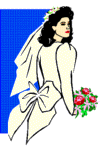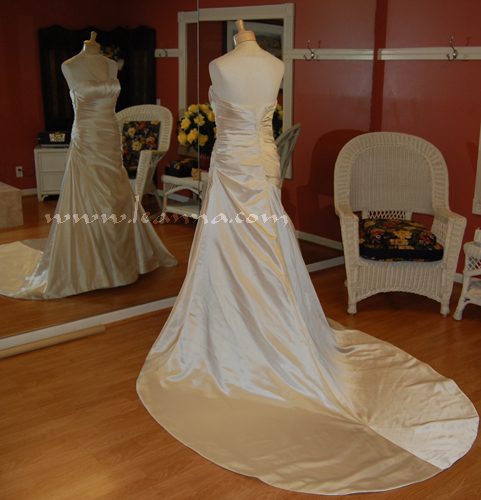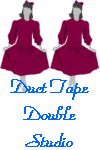Bustles are great things to have. They hold the train up so your
guests don't have to worry about stepping on it at your reception. There
are many possible ways to make a gown bustle depending on the size and
shape of the train and the decoration. The decision of how to bustle
your gown may be a difficult one so here are some pictures and explanations
to help you.
Before I show you the pictures, let me explain a little about bustle riggings. Hooks, eyes, buttons, loops, and ribbons are sewn in the train in specific places and ways to for the support of the bustle when it is up (I call this being rigged). These riggings often can be seen when the bustle is down, or not rigged. Brides often are very specific about not wanting ANYTHING odd showing on the backs of their trains for the ceremony. There is nothing wrong with wanting your gown to be perfect for your wedding day, but I must stress to all of you that visible bustle riggings do not mar the beauty of the train. If there is no decoration on the train that these elements can be hidden in, than they are going to be in the open, but they are very small and I have never heard a wedding guest make a comment about these tiny items on the train. Although visible, they are just never noticed. Trying to hide these items by adding decoration to an unadorned train often makes them more noticeable. So, I recommend that these items be sewn as simply as possible and that the bride work on understanding that they are not as odd as she is thinking.
Having said that - there are many ways to hide riggings. Lace and beading on the train can be a great place to position eyes so they seem like part of the lace. Buttons can be purchased that look like the beading that is already on the gown and will blend in though they are obviously added. If the gown already has satin covered buttons running down the center back seam, more of the same buttons can be sewn for the bustle riggings and guests won't think anything of them even though they are placed along the waist seam. Often, I have found that I can use the original buttons on the center seam of the gown to support a bustle by reinforcing them with stronger thread.
If there is some decoration already on the train, more can be added to hide bustle points that need to be positioned were there is no decoration. I have often taken lace from the inside of a seam I had to take in on the bodice and added it to the train where loops or hooks needed to be sewn for the bustle.
And, even if the train is totally unadorned, you can sometimes add a small amount of beads and/or lace to cover the bustle points if there are several points and the pattern results in what might normally be seen on a train. Otherwise, I strongly advise against trying to cover points with decoration. It only serves to bring more attention to them when you are trying to disguise them.
To add one more point about points showing. In the pictures here there are points that show. As you look at the pictures, if you find it hard to see the points, than so will your guests at the ceremony. Making them small and neat is the best way to make them as inconspicuous as possible.
|

![]()





































